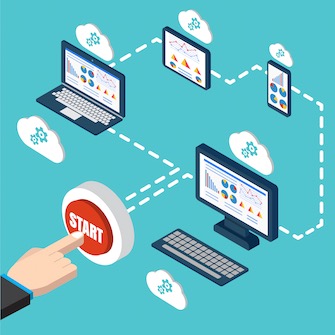 Lean technology, often called "Lean software" or "Lean management software," is a category of applications and lean manufacturing tools designed to support and facilitate Lean principles within any organization dedicated to operational excellence. These solutions help organizations streamline operations, reduce waste, improve efficiency, and ultimately deliver higher-quality products while minimizing costs.
Lean technology, often called "Lean software" or "Lean management software," is a category of applications and lean manufacturing tools designed to support and facilitate Lean principles within any organization dedicated to operational excellence. These solutions help organizations streamline operations, reduce waste, improve efficiency, and ultimately deliver higher-quality products while minimizing costs.
Lean technology supports efforts to perfect production processes, which are crucial for competitiveness because they directly impact an organization's ability to deliver value to customers, adapt to changing market conditions, and operate efficiently.
This post explores the benefits, strategies, and real-world applications of Lean technology for enhancing efficiency.
Principles of Lean Technology
Inspired by the Toyota Production System, Lean management principles emphasize eliminating waste, continuous improvement, and customer-centricity. At its core, Lean technology and Lean manufacturing management seek to optimize processes by identifying and eliminating inefficiencies, reducing unnecessary inventory, minimizing defects, and empowering employees to participate in problem-solving and decision-making. Its primary focus is delivering value to customers by focusing on their specific needs and preferences, ultimately driving greater efficiency, quality, and competitiveness within organizations and manufacturing plants. Lean technology supports five underlying Lean principles:
Value
The Lean principle of "value" centers on the concept that the customer defines value. In essence, any product, service, or process should only include activities or features directly contributing to meeting customer needs and requirements. In Lean technology, anything else is considered wasteful and should be eliminated or minimized, particularly the seven wastes of Lean. This Lean technology principle encourages organizations to thoroughly understand their customers, their preferences, and what they are willing to pay for. By aligning raw materials, processes, and efforts to deliver this customer-defined value while eliminating non-value-added activities using Lean technology, organizations can become more efficient, reduce costs, and enhance their competitiveness in the market.
Value Stream
The Lean technology idea of "value stream mapping" is a visual tool and technique used to analyze and improve organizational processes. It involves creating a detailed visual representation, typically in the form of a flowchart or map, of the entire manufacturing process from start to finish, including all the steps, people, raw materials, and information involved in delivering a product or service. The critical purpose of value stream mapping in Lean technology is to identify and eliminate waste (non-value-added activities) while optimizing the flow of value-added activities. Once the current state is understood, a future state map is created with proposed improvements to achieve a more streamlined and efficient process.
Flow
The Lean technology principle of "flow" emphasizes the smooth and uninterrupted movement of work or raw materials through a process. It is a bedrock concept in Lean manufacturing management that aims to eliminate workflow interruptions, delays, and disruptions. In essence, flow seeks to create a continuous and efficient process where work moves steadily and swiftly from one stage to the next without unnecessary waiting or batching.
The concept of flow is essential for reducing lead times, increasing productivity, and enhancing the ability to respond quickly to customer demand changes. By smoothing the flow of work and minimizing interruptions, organizations can operate more efficiently, reduce costs, and deliver products or services to customers more rapidly, ultimately improving their competitiveness in the market.
Pull
"Pull" is a lean manufacturing tool and methodology that focuses on aligning production or work processes with actual customer demand. Instead of pushing products or work through a manufacturing process based on forecasts or arbitrary schedules, the "pull" principle dictates that production or work should be initiated in response to specific customer orders or requests.
In Lean technology, the pull principle is closely associated with the idea of Just-in-Time (JIT) manufacturing and is a core concept in Lean manufacturing management. It helps organizations reduce lead times, improve resource utilization, and minimize waste, contributing to increased efficiency, customer satisfaction, and competitiveness.
Perfection
The Lean technology concept of "perfection" represents the ultimate goal of continuous improvement within the Lean manufacturing management philosophy. It signifies the relentless pursuit of excellence, eliminating all forms of waste, and the commitment to delivering the highest quality products or services to customers. While achieving perfection is often recognized as an ideal that may be unattainable in the practice of a manufacturing process, it serves as a guiding principle to drive ongoing organizational improvement projects and efficiency.
Improving Organization Efficiency with Lean Technology
Lean technology plays a crucial role in supporting the principles of Lean management in various ways. It can enhance efficiency, reduce waste, and facilitate continuous improvement. Here are some key ways in which improvement software for manufacturing supports Lean principles:
Process Mapping and Visualization: Technology can be used to create visual representations of processes, such as flowcharts and maps. This helps identify bottlenecks, waste, and opportunities for improvement, aligning with the principles of flow and value stream mapping.
Data Analytics: Software tools can collect and analyze data related to processes, performance metrics, and customer feedback. This data-driven approach aligns with the principle of using data for decision-making and continuous improvement.
/Charts/Threshold%20Chart.png?width=494&height=301&name=Threshold%20Chart.png)
Standardization: Lean practices emphasize standard work processes. Software can enforce and document standardized procedures, ensuring that work is consistently performed according to best practices.
Visual Management: Digital dashboards and visual management tools within the software can make monitoring the status of processes and key performance indicators easy, promoting transparency and accountability.
Continuous Improvement: Software can support ongoing improvement initiatives by tracking progress, storing historical data, and providing a platform for teams to collaborate on problem-solving and idea-sharing.
Project Management: Lean manufacturing often involves projects to improve processes. Project management technology can help plan, execute, and track these projects efficiently.
Communication and Collaboration: Collaboration tools and communication software support cross-functional teams in sharing information, discussing issues, and collaborating on Lean projects.
In short, technology plays a vital role in enabling organizations to implement and sustain Lean principles by providing the tools and capabilities needed to visualize, manage, and optimize processes, gather and analyze data, and foster a culture of continuous improvement. It enhances an organization's ability to eliminate waste, increase efficiency, and deliver maximum value to customers more effectively.
The Role of Lean Technology in Business: Applying Lean Technology
Implementing lean appropriate technological solutions, including quality improvement software for automotive manufacturing, aligned with Lean principles is essential for optimizing processes and achieving efficiency. Here's guidance on how to choose the right technologies, including automation tools, data analytics platforms, and cloud computing, in line with Lean principles:
Start with a Lean Assessment:
Before considering specific technologies, thoroughly assess your existing processes to identify areas where technology can add value.
Determine which Lean manufacturing principles (e.g., value, flow, pull, perfection) are most relevant to your organization's goals and challenges.
Prioritize Based on Impact:
Identify the processes or areas where technology can significantly impact eliminating waste, improving flow, and enhancing overall efficiency.
Use tools like process mapping, value stream mapping, and data analysis to prioritize areas for improvement.
Embrace Data Analytics Platforms:
Invest in data analytics platforms to gather, process, and analyze data related to your processes. This enables you to identify patterns, trends, and anomalies, facilitating data-driven decision-making.
Utilize predictive analytics to forecast demand, optimize inventory levels, and anticipate maintenance needs, aligning with the pull principle.
Consider Cloud Computing:
Adopt cloud computing to scale your IT infrastructure based on demand. Cloud platforms like AWS, Azure, and Google Cloud offer flexible resources, supporting Lean practices by reducing excess capacity.
Explore SaaS solutions that align with your needs, such as cloud-based improvement management tools, CRM systems, or ERP software, to streamline processes and reduce IT maintenance overhead.
Facilitate Continuous Improvement:
Select technologies that provide reporting and monitoring capabilities. Real-time dashboards and analytics help monitor key performance indicators (KPIs) and identify areas for continuous improvement.
Encourage a culture of continuous improvement by using technology to track and measure progress toward Lean goals.
Monitor and Adapt:
Regularly review the impact of the chosen technologies on your processes and Lean initiatives.
Be prepared to adapt and refine your technology stack as your organization's needs and Lean goals evolve.
Overcoming employee resistance to new technology that supports Lean principles requires a multifaceted approach. Start by clearly communicating the rationale behind the technology adoption, emphasizing how it aligns with Lean principles to streamline processes, reduce workload, and enhance job satisfaction. Involve employees in decision-making and ask for their input on technology selection and implementation. Provide comprehensive training and ongoing support, ensuring that employees are confident and competent in using the new tools. Foster a culture of experimentation and learning, encouraging employees to suggest technological improvements and adjustments. Finally, recognize and celebrate early successes and the positive impact of the technology, reinforcing the idea that it enhances rather than threatens their roles, ultimately promoting buy-in and cooperation from the workforce.
Conclusion
By following these guidelines and aligning Lean technology choices with Lean manufacturing principles, you can enhance your organization's efficiency, reduce waste, and continually strive toward perfection in your processes. The right technology is a powerful enabler of Lean manufacturing practices, supporting your journey to optimize the value stream to customers while optimizing resource utilization.




Add a Comment